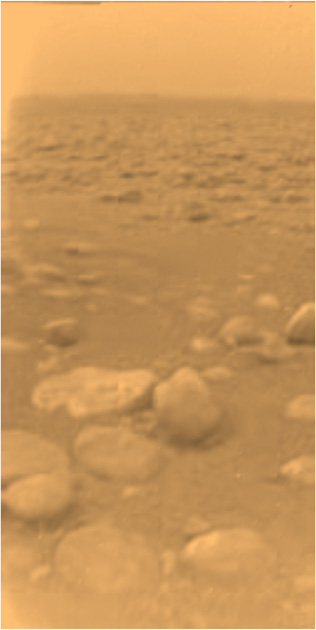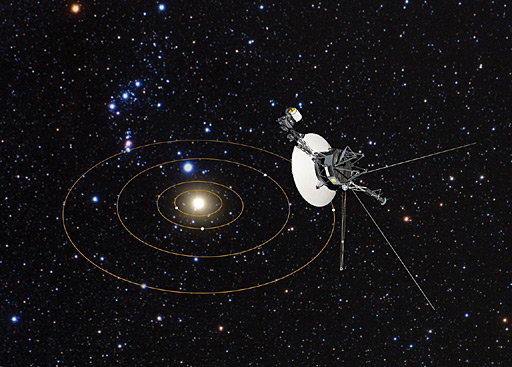 |
 |
|
||||
|
By
Wikipedia, A space probe is a robotic spacecraft that does not orbit the Earth, but, instead, explores further into outer space. A space probe may approach the Moon; travel through interplanetary space; flyby, orbit, or land on other planetary bodies; or enter interstellar space.
A planned 1974 probe, Pioneer H, on display in the National Air and Space Museum.
See List of active Solar System probes for a list of active probes; the space agencies of the USSR (now Russiaand Ukraine), the United States, the European Union, Japan, China and India have in the aggregate launched probes to several planets and moons of the Solar System as well as to a number of asteroids and comets. Approximately fifteen missions are currently operational. Space probes operational as of December 2016 (click to enlarge)
Interplanetary trajectoriesOnce a probe has left the vicinity of Earth, its trajectory will likely take it along an orbit around the Sun similar to the Earth’s orbit. To reach another planet, the simplest practical method is a Hohmann transfer orbit. More complex techniques, such as gravitational slingshots, can be more fuel-efficient, though they may require the probe to spend more time in transit. Some high Delta-V missions (such as those with high inclination changes) can only be performed, within the limits of modern propulsion, using gravitational slingshots. A technique using very little propulsion, but requiring a considerable amount of time, is to follow a trajectory on the Interplanetary Transport Network. Some notable probes
Luna 9First man-made object to soft land on the Moon, or any other extra terrestrial surface. Luna 3First mission to photograph the far side of the Moon, launched in 1959. Luna 16First robotic sample return probe from the Moon. Lunokhod 1First rover on Moon. It was sent to the Moon on November 10, 1970. Mariner 10First probe to Mercury. Venera 4First successful in-place analysis of another planet. It may have also been the first space probe to impact the surface of another planet, although it is unclear whether it reached Venus’ surface. Venera 7The Venera 7 probe was the first spacecraft to successfully soft land on another planet (Venus) and to transmit data from there back to Earth. Mariner 9Upon its arrival at Mars on November 13, 1971, Mariner 9 became the first space probe to maintain orbit around another planet. 
The Huygens landing site on Titan Mars 3First soft landing on Mars (December 2, 1971) The lander began transmitting to the Mars 3 orbiter 90 seconds after landing. After 20 seconds, transmission stopped for unknown reasons. SojournerFirst successful rover on Mars. Spirit and OpportunityThe Mars Exploration Rovers, Spirit and Opportunity surface and geology, and searched for clues to past water activity on Mars. They were each launched in 2003 and landed in 2004. Communication with Spirit stopped on sol 2210 (March 22, 2010). JPL continued to attempt to regain contact until May 24, 2011, when NASA announced that efforts to communicate with the unresponsive rover had ended. Opportunity arrived at Endeavour crater on 9 August 2011, at a landmark called Spirit Point named after its rover twin, after traversing 13 miles (21 km) from Victoria crater, over a three-year period.As of January 26, 2016, Opportunity has lasted for more than twelve years on Mars — although the rovers were intended to last only three months. Halley ArmadaThe first dedicated missions to a comet; in this case, to Halley’s Comet during its 1985–86 journey through the inner Solar System. It was also the first massive international coordination of space probes on an interplanetary mission, with probes specifically launched by the Soviet (now Russian) Space Agency, European Space Agency, and Japan’s ISAS (now integrated with NASDA to JAXA). ICEOriginally a solar observatory in the International Sun-Earth Explorer series, it was sent into solar orbit to make the first close observations of a comet, Comet Giacobini-Zinner, in 1985 as a prelude to studies of Halley’s Comet. VegaTwo Russian/French spacecraft. They dropped landers and balloons (first weather balloons deployed on another planet) at Venus before their rendezvous with Halley’s Comet. SakigakeThis Japanese probe was the first non-US, non-Soviet interplanetary probe. SuiseiA second Japanese probe, it made ultraviolet wavelength observations of the comet. GiottoThe first space probe to penetrate a comet’s coma and take close-up images of its nucleus. GenesisFirst solar wind sample return probe from sun-earth L1. StardustFirst sample return probe from a comet tail. NEAR ShoemakerFirst probe to land on an asteroid. HayabusaFirst sample return probe to launch from an asteroid. RosettaThe Rosetta space probe flew by two asteroids and made a rendezvous and orbited comet 67P/Churyumov-Gerasimenko in November 2014. Pioneer 10First probe to Jupiter. Radio communications were lost with Pioneer 10 on January 23, 2003, because of the loss of electric power for its radio transmitter, with the probe at a distance of 12 billion kilometers (80 AU) from Earth. Pioneer 11First probe to fly by two planets and first probe to Saturn. (Communications were lost due to power constraints and vast distance.) Voyager 1
Voyager 1′s view of Solar System (artist’s impression). Voyager 1 is a 733-kilogram probe launched September 5, 1977. It is currently still operational, making it the longest-lasting mission of the U.S. National Aeronautics and Space Administration (NASA). It visited Jupiter and Saturn and was the first probe to provide detailed images of the moons of these planets. Voyager 1 is the farthest human-made object from Earth, traveling away from both the Earth and the Sun at a relatively faster speed than any other probe. As of September 12, 2013, Voyager 1 is about 12 billion miles (19 billion kilometers) from the Sun. On August 25, 2012, Voyager 1 became the first human made object to enter interstellar space. Voyager 1 has not had a functioning plasma sensor since 1980, but a solar flare in 2012 allowed scientists from NASA to measure vibrations of the plasma surrounding the craft. The vibrations allowed scientists to measure the plasma to be much denser than measurements taken in the far layers of our heliosphere, thus concluding the craft had broken beyond the heliopause. Voyager 2Voyager 2 was the first probe to complete the Planetary Grand Tour of the gas giants, and the first probe to visit Uranus and Neptune. Voyager 2 is the second-farthest human-made object from Earth, next to Voyager 1 at a distance of 101.2 AU as of July 11, 2013. Cassini-HuygensLaunched on October 15, 1997. Significantly expanded our knowledge of Saturn’s ringed system. The lander, Huygens, landed on Titan on January 14, 2005. New HorizonsFirst probe to be launched to Pluto. Launched on 19 January 2006, it flew by the Pluto–Charon system on 14 July 2015. DawnFirst spacecraft to visit and orbit a protoplanet (4 Vesta), entering orbit on July 16, 2011. Entered orbit around dwarf planet Ceres in early 2015. Currently orbiting Ceres as of February 2017. JunoFirst probe to Jupiter without atomic battery, launched August 8, 2011. Chang’e 2Chang’e 2 was deployed to orbit the Moon, visit Sun–Earth L2 Lagrangian point, and make a flyby of asteroid 4179 Toutatis. Beyond the Solar SystemAlong with Pioneer 10, Pioneer 11, and its sister space probe Voyager 2, Voyager 1 is now an interstellar probe. Voyager 1 and 2 have both achieved solar escape velocity, meaning that their trajectories will not return them to the Solar System. Probe imagersExamples of space probe imaging telescope/cameras (focused on visible spectrum).
Image forming systems on space probes typically have a multitude of specifications, but aperture can be useful because it constrains the best diffraction limit and light gathering area.
Text from Wikipedia is available under the Creative Commons Attribution/Share-Alike License; additional terms may apply.
Published in October 2017. Click here to read more articles related to aviation and space!
|

 |
|
Copyright 2004-2025 © by Airports-Worldwide.com, Vyshenskoho st. 36, Lviv 79010, Ukraine Legal Disclaimer |